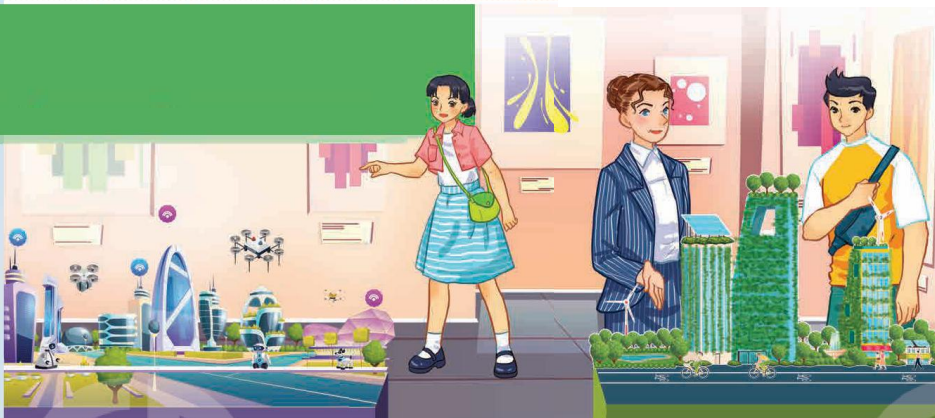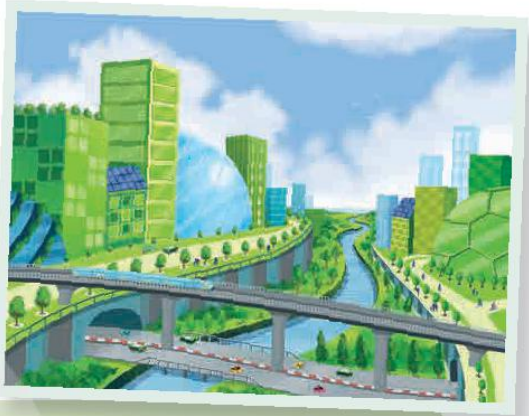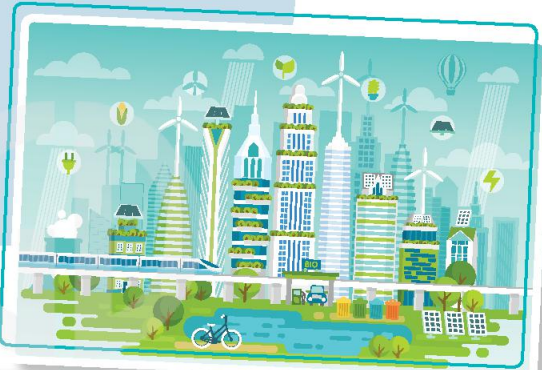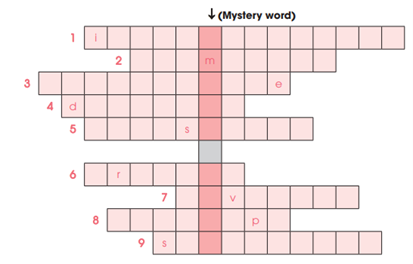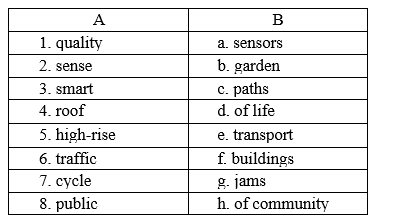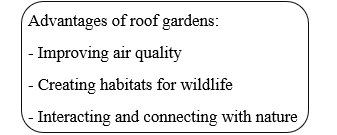Giải SGK, SBT Unit 3. Cities of the future Global Success
Giải SGK, SBT Unit 3 Global Success
2. Read the conversation again and complete the notes. Use no more than TWO words for each blank.
(Đọc đoạn hội thoại một lần nữa và hoàn thành các ghi chú. Sử dụng không quá HAI từ cho mỗi chỗ trống.)
|
Future cities |
|
|
Green city |
Smart city |
|
- More than 50% of it is made up of (1) ___________. - Using public transport will help reduce (2) ___________ and pollution.
|
- AI (3) ___________ will help the city operate more efficiently. - High-rise buildings will help solve the (4) ___________ problems |
3. Match the words to make phrases mentioned in 1.
(Nối các từ để tạo thành các cụm từ được đề cập trong phần 1.)
|
1. public |
a. city |
|
2. private |
b. infrastructure |
|
3. modern |
c. transport |
|
4. high-rise |
d. vehicles |
|
5. smart |
e. buildings |
Cities and smart living
(Các thành phố và lối sống thông minh)
1. Match the words and phrases with their meanings.
(Nối các từ và cụm từ với ý nghĩa của chúng.)
|
1. city dweller (np) |
a. a garden built on the top of a building |
|
2. traffic jam (n) |
b. a very tall, modern building, usually in a city |
|
3. urban center (np) |
c. a person who lives in the city |
|
4. roof garden (n) |
d. a situation of too many vehicles on the road so that they can move only slowly are are stopped completely |
|
5. skyscraper (n) |
e. an area in a city where a large number of people live. |
3. Read the article again and decide whether the statements are true (T) or false (F).
(Đọc bài báo một lần nữa và quyết định xem những câu phát biểu là đúng (T) hay sai (F).)
|
|
T |
F |
|
1. About 70 million people will live in cities by 2050. |
|
|
|
2. Smart cities use modern technologies to save time and provide better services. |
|
|
|
3. City dwellers will be able to grow vegetables underground or in roof gardens. |
|
|
|
4. Space for walking and cycling will be replaced with computer-controlled transport systems. |
|
|
2. Match the questions with the answers to make a conversation. Then practice it in pairs.
(Nối các câu hỏi với các câu trả lời để tạo thành một đoạn hội thoại. Sau đó thực hành nó theo cặp.)
|
1. What do you think transport will be like in the cities of the future? |
a. They will use public transport instead of their own vehicles. |
|
2. So, how will people travel in the city? |
b. Because technology will make public transport faster, more convenient, and more eco-friendly. |
|
3. Really? Why do you think public transport will be popular with city dwellers? |
c. Well, I think there will be no private vehicles in the cities. |
Living in a smart city
(Việc sống trong thành phố thông minh)
1. Match the words and phrases with their meanings.
(Nối các từ và cụm từ với ý nghĩa của chúng.)
|
1. interact |
a. an area of a town |
|
2. privacy |
b. the feeling of belonging to a group |
|
3. sense of community |
c. to talk or do things with other people |
|
4. neighbourhood |
d. the state of being alone and not watched or interrupted by other people |
3. Listen to the interview again and complete the table. Use no more than THREE words for each answer.
(Nghe lại cuộc phỏng vấn và hoàn thành bảng. Sử dụng không quá BA từ cho mỗi câu trả lời.)
|
Situations |
Problems |
|
There are cameras and sensors everywhere. |
City dwellers may lose their (1) _________ in public areas. |
|
People use (2) _________ to help them with household chores. |
It is not easy for some people to get familiar with and use the smart devices. |
|
City dwellers don't (3) _________ with many people face to face. |
There is no (4) __________ in the neighbourhood. |
An article about the advantages and disadvantages of living in a smart city
(Một bfai báo về những thuận lợi và bất lợi của việc sống trong một thành phố thông minh)
1. Read the following ideas and decide whether they are advantages or disadvantages of living in a smart city. Tick (✔) the appropriate box.
(Đọc những ý tưởng sau đây và quyết định xem chúng là lợi thế hay bất lợi khi sống trong một thành phố thông minh. Đánh dấu (✔) vào ô thích hợp.)
|
|
Advantages |
Disadvantages |
|
1. Smart technologies make people’s lives easier by reducing household chores. |
|
|
|
2. Without training, people will not know how to use the technologies in the smart city. |
|
|
|
3. People have limited privacy due to cameras installed everywhere in the city. |
|
|
|
4. The negative impact on the environment is less. |
|
|
|
5. Smart technologies help the city operate more efficiently. |
|
|
|
6. People become worried because their personal information might not be protected. |
|
|
1. Read the text on page 36 and decide in which city you can do the following.
(Đọc văn bản ở trang 36 và quyết định bạn có thể làm những việc sau ở thành phố nào.)
|
1. book a parking space via a mobile app (đặt chỗ đậu xe qua ứng dụng di động) |
Singapore |
|
2. have a medical check-up online |
|
|
3. use your bank card to pay for traveling on the bus or underground |
|
|
4. unlock your bike from one station and return it to any other station in the city |
|
|
5. use a mobile app to help you choose the best route to cycle in the city |
|
SMART CITIES AROUND THE WORLD
Cities around the world are becoming smarter, and you can do many things that seemed impossible in the past.
In Singapore, the mobile app Parking.sg allows you to locate a nearby car park easily, book a parking space, and make a payment. You can also extend your booking or receive a refund if you leave early.
New York City (US) has one of the largest bike-sharing systems called Citi Bike. Using a mobile app, you can unlock bikes from one station and return them to any other station in the system, making them ideal for one-way trips.
In Copenhagen (Denmark), you can use a mobile app to guide you through the city streets and tell how fast you need to pedal to make the next green light. The app can also give you route recommendations and work out the calories you burn.
In London(UK), you don’t have to buy public transport tickets. You can just touch your bank card on the card reader when you get on and off the bus or the underground to pay for your trip.
In Toronto (Canada), you can book an appointment and see a doctor online a from your own home. You can also receive prescriptions and any other documents you need, all online.
3. Write an article (120-150 words) about the advantages and disadvantages of roof gardens in the city. Use the ideas below to help you.
(Viết một bài viết (120-150 từ) về những thuận lợi và khó khăn của khu vườn trên mái nhà trong thành phố. Sử dụng những ý tưởng dưới đây để giúp bạn.)
|
Advantages (Lợi ích) |
Disadvantages (Bất cập) |
|
- Improving air quality (Cải thiện chất lượng không khí) - Creating habitats for wildlife (Tạo môi trường sống cho động vật hoang dã) - Interacting àn connecting with nature (Tương tác và kết nối với thiên nhiên) |
- Being expensive (Đắt đỏ) - Increasing weight on the structure (Tăng sức nặng lên cấu trúc) - Being difficult to repair and maintain (Khó cải tạo và duy trì) |













